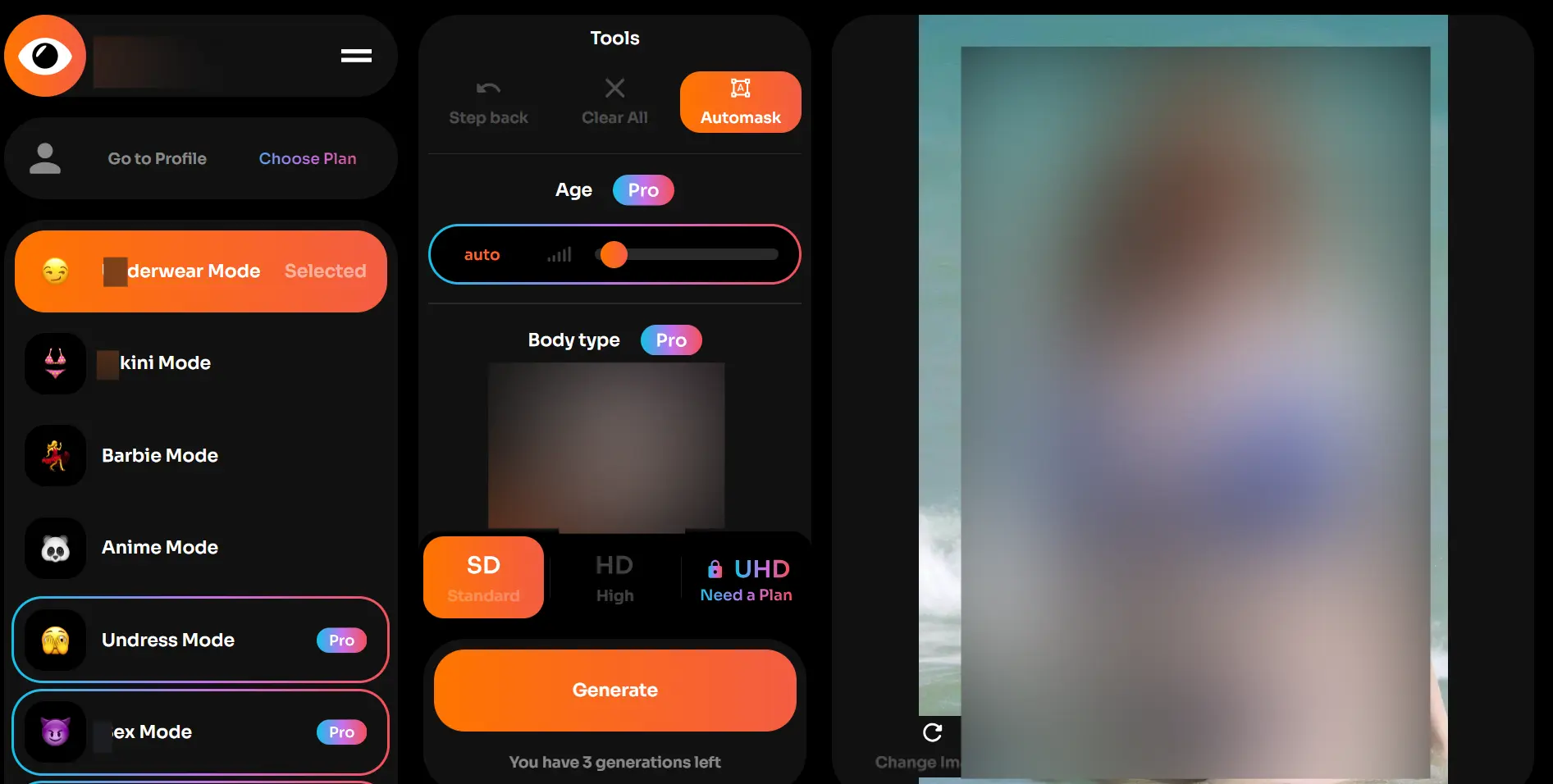In an era defined by technological leaps and the pervasive nature of digital imagery, can artificial intelligence truly reshape the very fabric of how we perceive and interact with photographs? The answer, strikingly, is yes, as AI-powered tools are now capable of altering images in ways previously confined to the realm of science fiction.
The rapid advancement of AI has ushered in a new era of image manipulation. Now it is easy to remove clothes from photos online. Its a reality where sophisticated algorithms can meticulously analyze and modify visual content with unprecedented precision. Tools like those offering "Try undressher ai free today!" and similar services have emerged, promising users the ability to effortlessly transform their images. These platforms use complex artificial intelligence models to detect and remove clothing, offering features like swapping outfits. This technological evolution raises complex questions about ethics, privacy, and the future of digital content. One can now "Easily remove clothes from photos online or swap clothes from any photo using the free ai clothes remover."
The mechanics behind these tools are relatively straightforward, yet profoundly sophisticated. The user typically begins by uploading a photo, a process often as simple as "Tap the upload button to load your photo to ptool's ai clothes remover tool." Once the image is loaded, the AI algorithms go to work, analyzing the image to identify clothing and other elements. The user then has the option to "Tap the generate button to erase the clothes using ai and swap it to the new outfit style you prefer." These tools enable users to "Remove clothes and items in your pictures in creative ways that are easy to do." This functionality, offered by platforms like "Unclothy," is designed to "let you try out different styles and looks." These systems are capable of generating altered images almost instantly. The process is streamlined, "The process is simple, with minimal steps required to generate altered photos."
The emergence of AI image alteration tools is a double-edged sword, presenting both incredible opportunities and significant risks. For those interested in creative applications, these tools can be a game-changer. They provide a platform to experiment with fashion and styles. They also offer a new level of editing capabilities, enabling the user to "modify your images in seconds with just a few clicks, delivering precise and personalized results every time." However, the same technology that enables creative expression can also be used for malicious purposes. The ability to generate deepnude images raises significant concerns about privacy, consent, and the potential for misuse.
The ethical implications of this technology are substantial. The creation and distribution of altered images without the consent of the depicted individual are a clear violation of privacy. This is especially concerning when these images are used to create explicit or offensive content. The potential for such abuse necessitates a careful consideration of the societal impact of these technologies. This also raises questions about how these tools should be regulated, and how users can be educated about the risks and responsibilities associated with their use. This also becomes important for the "Users can edit images precisely, erasing imperfections, smoothing skin texture, and more."
Platforms such as "clothoff" have emerged, aiming to streamline the image alteration process. These services often tout their user-friendliness and efficiency. "Experience clothoff, the ultimate ai clothes remover," is one such example. They are often promoted as tools to "Easily remove clothes with ai technology using our free and efficient cloth remover ai tool." This ease of access and the increasing sophistication of the technology make it even more crucial to discuss the potential for abuse and the necessity for responsible use. The ease of access also makes it very important to address the creative side of the tools, that also offers unique features, such as users can "Transform your images effortlessly with our ai clothes remover," and "Experience the magic of advanced technology that seamlessly replaces clothing in photos, making your creative vision a reality."
Let's delve into the core capabilities and underlying mechanisms of these AI-driven tools. The focus is on the technical aspects and the ways these algorithms achieve their impressive results. These tools often leverage advanced AI models. A significant aspect is the use of sophisticated image recognition algorithms, which are trained on vast datasets of images to identify objects and patterns within a photo. These algorithms are designed to "By leveraging advanced ai models, users can upload images, and the tool will automatically detect and remove clothing, generating deepnude images." This process involves several key steps, from image analysis to the actual modification.
The initial step is image analysis, where the AI system scans the uploaded photo to identify key features and objects. This involves identifying the presence of clothing, skin tones, and body shapes. Once the objects are identified, the system creates a detailed map of the image, outlining the areas to be altered. With the use of AI models, the application then proceeds to remove the clothing, replacing it with a representation of the underlying body. The algorithms use a combination of techniques. The techniques are like texture mapping and inpainting to create a realistic look. This involves filling in the areas where the clothing was previously with appropriate visual data, making the transition appear seamless.
The final stage in the process includes image enhancement and refinement. This includes making adjustments to skin tones, lighting, and shadows. The tools enhance the realism of the resulting image. The entire process from start to finish can be done "Try it now and explore its features!" Some platforms also offer options for customizing the final output, enabling users to select different styles, adjust the level of detail. The features can then tailor the altered image to their preferences. These tools are incredibly useful for creating altered images, but it is essential to remember the potential downsides. This is particularly important when considering the possibility of generating deepnude images.
The evolution of AI-powered image alteration tools marks a pivotal moment in the intersection of technology and society. These tools, while offering exciting new possibilities, also come with significant ethical considerations that cannot be ignored. Users of these platforms must proceed with caution, recognizing both the power and the potential pitfalls of the technology. The capacity of AI to modify visual content is rapidly evolving. To navigate this new landscape responsibly, we must adopt a thoughtful and informed approach, balancing the potential for innovation with a firm commitment to ethical considerations and the protection of individual rights.
As technology continues to advance, it is imperative that we maintain a constant dialogue about the implications of these tools. This discussion must involve experts from various fields. These include AI researchers, ethicists, legal professionals, and policymakers. Collaboration across sectors is essential to ensure the responsible development and deployment of AI image alteration technologies. The goal is to harness their capabilities for creative and positive purposes. The aim must be to mitigate the risks associated with their misuse. The future of digital content is being shaped right now.
The legal and regulatory landscape is adapting to the challenges posed by AI-driven image manipulation. The legal frameworks and policies are continually evolving to address the ethical and privacy concerns. These concerns arise from the creation of altered images. The key challenges include determining the extent to which existing laws cover the generation of deepfakes and other manipulated content. The need is for new legislation and guidelines to address the unique characteristics of AI-generated images. These include the potential for deepfakes, which can cause significant reputational damage and emotional distress to individuals.
The debate over regulation centers on balancing the need to protect individual rights and prevent misuse. It also considers the need to foster innovation and creative expression. The debate involves creating legal mechanisms for holding individuals and entities accountable for the misuse of AI-generated images. These mechanisms must also consider promoting media literacy and providing education. The aim is to help users recognize manipulated content. This is a crucial step in empowering individuals. The aim is to navigate the digital landscape responsibly. The need for effective regulations is essential. The regulations should also align with ethical principles. The regulations can help to safeguard fundamental human rights in the digital age.
The future of AI image alteration tools is filled with opportunities and challenges. Continued advances in AI technology will lead to even more sophisticated and realistic image manipulation capabilities. This could potentially result in more realistic and customizable alterations. This is likely to create new challenges for detecting and verifying the authenticity of images. There will also be the potential for even greater misuse and ethical concerns. However, with appropriate regulations and responsible usage, the evolution of these tools may also enable many creative opportunities. The impact of AI in this domain is growing rapidly. This requires a proactive and multi-faceted approach to manage its ethical considerations.
The responsibility of users must be to approach these tools with awareness. The user must understand the potential implications of their actions. The users should prioritize ethical considerations when creating and sharing altered images. This includes respecting the privacy and consent of individuals depicted in images. This also includes avoiding the creation of content that could be used for malicious purposes. The importance of media literacy and critical thinking is also very important for the users. This enables them to discern between authentic and manipulated images. It also protects them from potential deception.
The impact of AI image alteration tools is expected to extend beyond the realm of image manipulation. The tools will have a broader impact on areas such as journalism, entertainment, and marketing. The tools can be used to create deepfakes, which can create challenges for the news and media industry. These will be used to spread misinformation and erode public trust. The entertainment industry might also find new ways to produce content. The marketing industry may also offer new ways to create engaging and personalized advertising campaigns. This technological revolution will continue to shape the way we see and interact with the world.
As the tools become more common, it is essential to adopt a forward-thinking approach. The approach is about balancing the innovative potential of these technologies with a commitment to ethical practice. The approach involves establishing clear guidelines and regulations that are designed to protect privacy. It also involves preventing the misuse of AI-generated images. The approach should involve the need for media literacy and education, which is crucial for the empowerment of people. The approach must also be about encouraging a broader conversation about the ethical and societal implications. The goal is to manage a future where technology, creativity, and ethics come together.
The development and adoption of AI image alteration tools are transforming the way we interact with and perceive visual content. The tools present opportunities. The tools also raise complex ethical, legal, and societal considerations. We must all work together. The collaborative efforts include AI developers, policymakers, and end-users to address these challenges. The goal is to ensure that these tools are used for good. The efforts are about respecting individual rights. The efforts are about promoting transparency and fostering a responsible digital environment. The future of AI image alteration tools depends on ethical and responsible usage.
The impact of AI on the visual world is more than just a technological shift. The evolution of AI offers us a chance to reconsider the definition of authenticity. The revolution also shows us to respect the fundamental human values. There is a need to create a future where technology and ethics can work together. The aim is to safeguard our privacy and promote a digital world. It is also about a place where creativity is cherished. The place should also be about responsibility.


